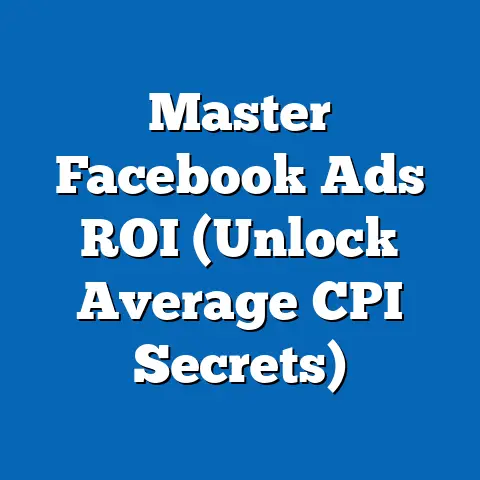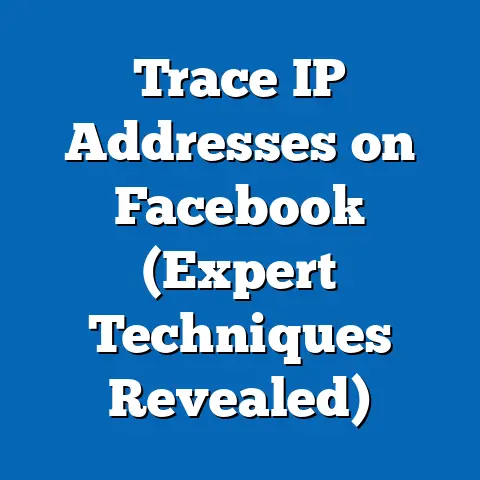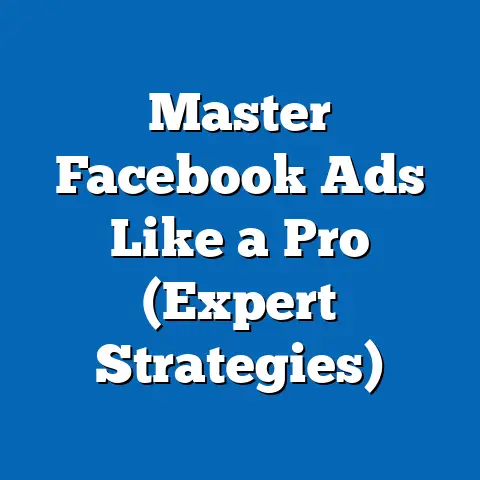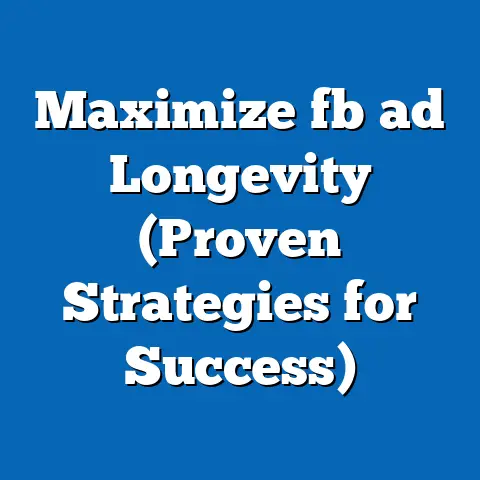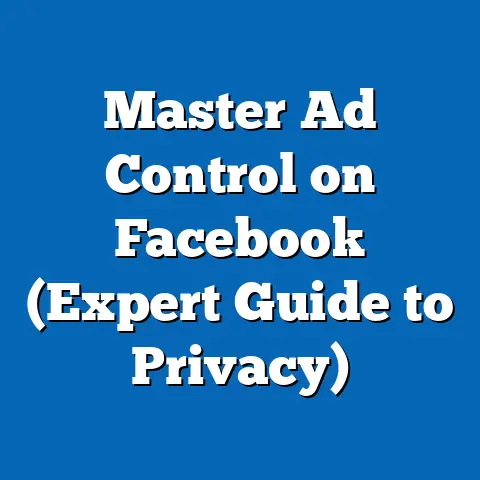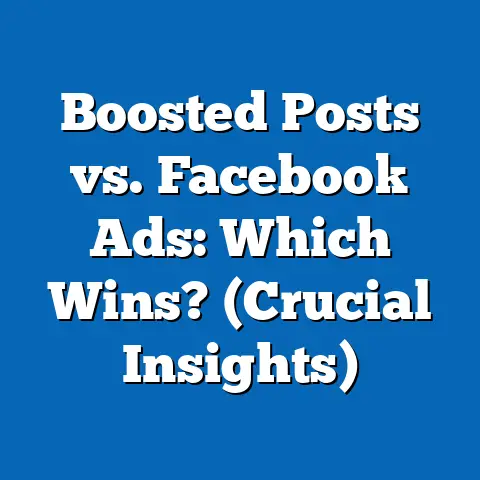Master Pay-Per-Click Ads on Facebook (Proven Strategies)
I’ve been working with Facebook ads for years, and I’ve seen firsthand how powerful they can be. But I’ve also heard a lot of misconceptions about them, especially when it comes to Pay-Per-Click (PPC) advertising. Some marketers dismiss it as a short-term fix, a money pit, or something only big corporations can afford. But I’m here to tell you that with the right strategies, Facebook PPC ads can be a game-changer for any business, regardless of size.
Let’s debunk some of these myths right now.
Myth 1: PPC Ads Are a Short-Term Solution, Not a Long-Term Strategy
This is a big one. Many think PPC is just for quick sales or temporary boosts. While it’s true that PPC can deliver immediate results, it can also be a cornerstone of your long-term marketing strategy. Think of it as planting seeds and nurturing them. You might see some sprouts quickly, but consistent effort and optimization will lead to a thriving garden over time.
I’ve seen companies build entire brands using Facebook PPC. They start with targeted ads, gather data, refine their approach, and build loyal customer bases. It’s not just about the clicks; it’s about the customer journey.
Myth 2: PPC Ads Are Too Expensive for Small Businesses
This is another common misconception. Yes, you can spend a fortune on Facebook ads, but you don’t have to. The beauty of PPC is that you control your budget. You can start small, test different strategies, and scale up as you see results.
I’ve worked with startups that started with just $5 a day and saw significant returns. It’s all about being smart with your targeting and creative. Don’t try to reach everyone; focus on the people who are most likely to convert.
Myth 3: PPC Ads Don’t Yield Measurable Results
I once helped a client increase their conversion rate by 300% just by analyzing their ad data and making a few tweaks. The key is to set up proper tracking, monitor your metrics, and be willing to experiment.
Myth 4: PPC Ads Are Ineffective Due to Ad Fatigue
Ad fatigue is real. People get tired of seeing the same ads over and over again. But it’s not an insurmountable problem. The solution is to keep your ads fresh and relevant.
I recommend rotating your ad creative regularly, testing new offers, and targeting different audience segments. Think of it like a TV show – you need new episodes to keep viewers engaged.
Now that we’ve cleared up some of the common myths, let’s dive into the core of the matter: mastering Facebook PPC ads.
1. Understanding Your Target Audience
This is where it all begins. You can have the best ad creative in the world, but if you’re showing it to the wrong people, it won’t work. Audience research and segmentation are crucial.
The Importance of Audience Research and Segmentation
Think of your target audience as a group of people with shared interests, needs, and behaviors. The more you know about them, the better you can tailor your ads to resonate with them.
I like to start by creating buyer personas. These are fictional representations of your ideal customers. Give them names, ages, occupations, and hobbies. What are their pain points? What are their goals? The more detailed you can make them, the better.
Using Facebook Audience Insights and Custom Audiences
Facebook offers two powerful tools for audience research: Audience Insights and Custom Audiences.
Facebook Audience Insights lets you explore the demographics, interests, and behaviors of people on Facebook. You can use it to discover new audience segments you might not have considered.
I remember using Audience Insights to help a local bakery target new customers. We discovered that people interested in “gluten-free recipes” and “organic food” were also likely to be interested in their products. We created a campaign specifically targeting this audience, and it was a huge success.
Custom Audiences allow you to target people based on your existing customer data. You can upload a list of email addresses, phone numbers, or website visitors and create a custom audience.
I’ve seen retargeting campaigns using Custom Audiences achieve incredibly high conversion rates. It’s like saying, “Hey, I noticed you were checking out our products. Here’s a special offer just for you.”
Examples of Successful Audience Targeting
- A fitness studio targets people interested in “yoga,” “Pilates,” and “healthy eating” in their local area.
- An e-commerce store retargets website visitors who added items to their cart but didn’t complete the purchase.
- A software company targets professionals in specific industries, such as “marketing managers” or “sales directors.”
Takeaway: Invest time in understanding your target audience. Use Facebook Audience Insights and Custom Audiences to identify and target the right people.
2. Crafting Compelling Ad Copy and Creative
Once you know who you’re targeting, you need to create ads that grab their attention and persuade them to take action.
Creating Engaging Ad Copy
Your ad copy should be clear, concise, and relevant to your target audience. Speak to their pain points and desires. What problem are you solving for them? What benefit are you offering?
I like to use the “AIDA” formula:
- Attention: Grab their attention with a compelling headline or image.
- Interest: Generate interest by highlighting a key benefit or feature.
- Desire: Create desire by showing how your product or service can improve their life.
- Action: Tell them what you want them to do next (e.g., “Shop Now,” “Learn More,” “Sign Up”).
The Significance of High-Quality Visuals and Video Content
In the crowded world of social media, visuals are king. High-quality images and videos can make all the difference in capturing attention and driving engagement.
I recommend using professional-looking visuals that are relevant to your brand and target audience. Avoid stock photos that look generic. Instead, use photos or videos that showcase your products or services in action.
Video content is especially powerful. It can tell a story, demonstrate a product, or simply entertain your audience. Short, attention-grabbing videos tend to perform best on Facebook.
Examples of Successful Ad Creatives
- Dollar Shave Club: Their humorous videos went viral and helped them build a massive customer base.
- Airbnb: They use stunning photos of unique properties to inspire wanderlust.
- Nike: They feature athletes and inspiring stories to motivate their audience.
I once helped a local restaurant create a series of mouth-watering food photos for their Facebook ads. The photos were so good that people started tagging their friends and saying, “We need to go here!”
Takeaway: Craft compelling ad copy that speaks to your audience’s needs and desires. Use high-quality visuals and video content to capture attention and drive engagement.
3. Setting Up Effective Campaigns
Now it’s time to put everything together and launch your Facebook PPC campaign.
Choosing the Right Campaign Objectives
Facebook offers a variety of campaign objectives, such as:
- Awareness: Reach a broad audience and increase brand awareness.
- Traffic: Drive traffic to your website or landing page.
- Engagement: Get more likes, comments, and shares on your posts.
- Leads: Collect leads through a lead generation form.
- Conversions: Drive sales or other desired actions on your website.
Choose the objective that aligns with your marketing goals. If you’re trying to build brand awareness, choose the “Awareness” objective. If you’re trying to drive sales, choose the “Conversions” objective.
Choosing the Right Ad Placements
Facebook offers a variety of ad placements, such as:
- Facebook Feed: Ads appear in the news feed on Facebook.
- Instagram Feed: Ads appear in the news feed on Instagram.
- Facebook Marketplace: Ads appear in the Facebook Marketplace.
- Audience Network: Ads appear on websites and apps outside of Facebook.
Experiment with different ad placements to see what works best for your target audience. I often recommend starting with the Facebook Feed and Instagram Feed, as these tend to be the most effective placements.
Choosing the Right Bidding Strategies
Facebook offers a variety of bidding strategies, such as:
- Lowest Cost: Facebook will try to get you the most results for your budget.
- Cost Per Result Goal: You set a target cost per result, and Facebook will try to achieve that goal.
- Manual Bidding: You set your own bids for each ad.
If you’re new to Facebook ads, I recommend starting with the “Lowest Cost” bidding strategy. As you gain more experience, you can experiment with other bidding strategies.
The Importance of A/B Testing
A/B testing involves creating two versions of an ad with one element changed (e.g., headline, image, call-to-action) and seeing which version performs better.
I can’t stress enough how important A/B testing is. It’s the only way to know for sure what resonates with your target audience.
I recommend A/B testing everything: headlines, images, ad copy, targeting options, and bidding strategies.
Budget Management
Set a daily or lifetime budget for your campaign. Monitor your budget closely and adjust it as needed.
I recommend starting with a small budget and scaling up as you see results. Don’t put all your eggs in one basket. Spread your budget across multiple ad sets and campaigns.
Takeaway: Set up your Facebook PPC campaign with clear objectives, the right ad placements, and a smart bidding strategy. Don’t forget to A/B test everything and manage your budget effectively.
4. Utilizing Facebook Pixel for Retargeting
Facebook Pixel is a small piece of code that you install on your website. It allows you to track user behavior on your website and retarget them with relevant ads on Facebook.
What is Facebook Pixel?
Facebook Pixel tracks actions such as:
- Page Views: When someone visits a page on your website.
- Add to Cart: When someone adds an item to their cart.
- Purchase: When someone completes a purchase.
You can use this data to create custom audiences and retarget them with relevant ads.
The Benefits of Retargeting Ads
Retargeting ads can dramatically improve your conversion rates. People who have already visited your website are more likely to convert than people who have never heard of you.
I’ve seen retargeting campaigns achieve conversion rates that are 2-3 times higher than regular campaigns.
Case Studies of Successful Retargeting Strategies
- An e-commerce store retargets website visitors who added items to their cart but didn’t complete the purchase with a special discount code.
- A software company retargets website visitors who downloaded a free trial with a limited-time offer for the full version of the software.
- A travel agency retargets website visitors who viewed a specific destination with ads showcasing hotels and activities in that destination.
I helped a local clothing store implement a retargeting campaign that showed ads to people who viewed specific products on their website. The ads featured the products they had viewed, along with a call-to-action to “Shop Now.” The campaign was so successful that they saw a 50% increase in online sales.
Takeaway: Install Facebook Pixel on your website and use it to track user behavior. Create custom audiences and retarget them with relevant ads to improve your conversion rates.
5. Analyzing and Optimizing Campaign Performance
Once your campaign is running, it’s important to monitor its performance and make adjustments as needed.
Key Metrics to Monitor
- Impressions: The number of times your ad was shown.
- Reach: The number of unique people who saw your ad.
- Clicks: The number of times people clicked on your ad.
- Click-Through Rate (CTR): The percentage of people who saw your ad and clicked on it.
- Conversion Rate: The percentage of people who clicked on your ad and completed a desired action (e.g., made a purchase, filled out a form).
- Cost Per Click (CPC): The average cost you paid for each click on your ad.
- Cost Per Conversion (CPC): The average cost you paid for each conversion.
- Return on Ad Spend (ROAS): The revenue you generated from your ad campaign divided by the amount you spent.
Using Facebook Ads Manager to Analyze Performance
Facebook Ads Manager provides a wealth of data and reporting tools. You can use it to track your campaign’s performance, identify trends, and make data-driven decisions.
I recommend checking your campaign performance at least once a day. Look for trends and outliers. What’s working? What’s not working?
Tips for Pivoting Strategies Based on Performance Data
- If your CTR is low: Try changing your headline, image, or ad copy.
- If your conversion rate is low: Make sure your landing page is relevant to your ad and easy to use.
- If your CPC is high: Try targeting a different audience or adjusting your bidding strategy.
- If your ROAS is low: Re-evaluate your entire campaign and make significant changes.
I once helped a client completely turn around a failing campaign by analyzing their performance data and making a few key changes. We discovered that their ads were performing well on mobile devices but poorly on desktop computers. We decided to focus our budget on mobile devices, and their ROAS increased by 400%.
Takeaway: Monitor your campaign performance closely and make data-driven decisions. Be willing to pivot your strategies based on what’s working and what’s not.
6. Staying Updated with Facebook’s Algorithm Changes
Facebook’s algorithm is constantly changing. What worked yesterday might not work today. It’s important to stay informed about changes in Facebook’s advertising policies and algorithms.
Why Staying Informed is Crucial
Facebook regularly updates its algorithm to improve the user experience and prevent abuse. These updates can have a significant impact on your ad performance.
I’ve seen companies lose a lot of money because they didn’t stay informed about algorithm changes.
Resources for Keeping Up with Industry News
- Facebook Business Help Center: The official source for information about Facebook’s advertising policies and features.
- Industry Blogs: Follow reputable marketing blogs and news sites to stay up-to-date on the latest trends and best practices.
- Social Media Groups: Join Facebook groups and online communities where marketers share their experiences and insights.
How Adaptability Has Helped Successful Brands
Successful brands are adaptable. They’re willing to experiment with new strategies and adjust their approach as needed.
I’ve seen companies thrive in the ever-changing world of Facebook advertising by being agile and responsive to new trends.
Takeaway: Stay informed about changes in Facebook’s algorithm and advertising policies. Be adaptable and willing to experiment with new strategies.
7. Leveraging User-Generated Content and Social Proof
User-generated content (UGC) is content created by your customers, such as reviews, testimonials, photos, and videos. Social proof is evidence that other people have had positive experiences with your product or service.
How UGC Enhances Credibility
UGC can significantly enhance the credibility of your ads. People are more likely to trust recommendations from other customers than they are to trust advertising claims from your company.
I’ve seen UGC-based ads outperform traditional ads by a wide margin.
Strategies for Encouraging Customers to Share Their Experiences
- Run contests and giveaways: Encourage customers to share photos or videos of themselves using your product or service.
- Ask for reviews and testimonials: Make it easy for customers to leave reviews on your website or social media pages.
- Feature customer content on your website and social media: Show your customers that you value their opinions.
Examples of Brands That Have Successfully Utilized UGC
- GoPro: They feature stunning photos and videos taken by their customers.
- Starbucks: They encourage customers to share photos of their coffee creations.
- Lululemon: They feature photos of customers wearing their activewear.
I helped a local clothing store create a campaign that featured photos of customers wearing their clothes. The photos were authentic and relatable, and they resonated with the target audience. The campaign was a huge success, and the store saw a significant increase in sales.
Takeaway: Leverage user-generated content and social proof to enhance the credibility of your ads. Encourage customers to share their experiences and feature their content in your campaigns.
Conclusion: Mastering Facebook PPC Ads for Sustainable Success
Mastering PPC ads on Facebook isn’t just about spending money; it’s about strategic planning, creativity, and continuous optimization. It’s about understanding your audience, crafting compelling ads, setting up effective campaigns, utilizing Facebook Pixel for retargeting, analyzing performance, staying updated with algorithm changes, and leveraging user-generated content.
With the right approach, businesses of all sizes can leverage Facebook PPC ads to achieve sustainable success and growth in their marketing efforts. Don’t be afraid to experiment, test new strategies, and adapt to the ever-changing world of social media advertising. The rewards are well worth the effort.
So, take these strategies, put them into action, and start mastering your Facebook PPC ads today! You might be surprised at the results you can achieve.

